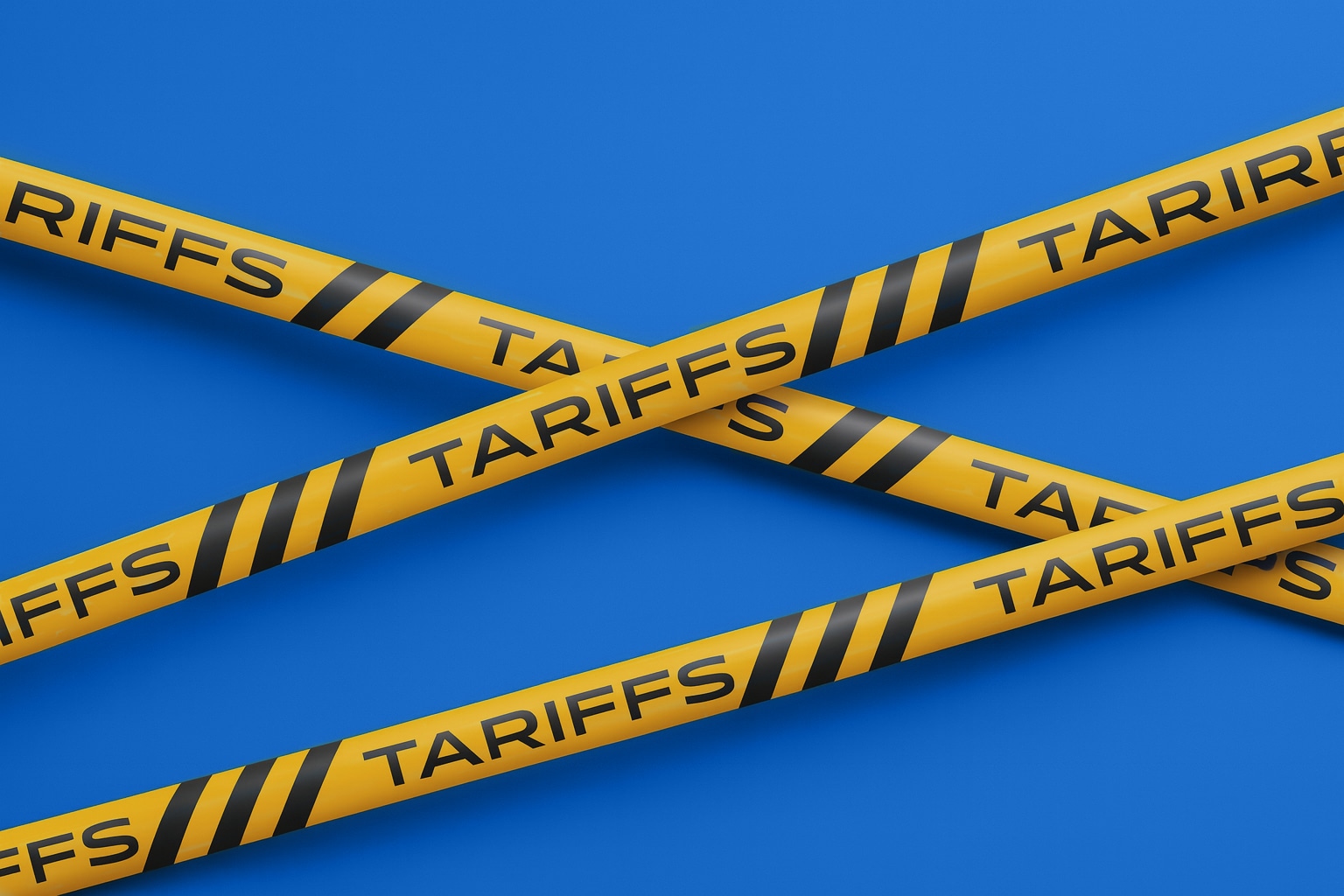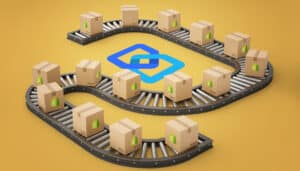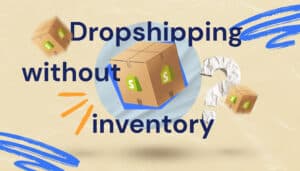Are sudden tariff changes putting your Shopify margins at risk? This guide shares automation strategies to make your ecommerce operations resistant to tariff volatility. Learn how to automate landed cost calculations, inventory workflows, supplier sourcing, and accounting, all designed to support Shopify stores facing 2025’s global trade disruptions.
This isn’t hypothetical; it’s the new reality for thousands of ecommerce merchants. “Tariffs have varied from 16% to 30%… Nobody knows from day to day what it’s going to be,” says Dottie Smith, gift-shop owner. “Building blocks… cost $3 to produce [will] now cost $7 including the tariff,” explains Brian Miller, an Amazon seller.
For more on automation and compliance, see our Shopify QuickBooks Sync strategies.
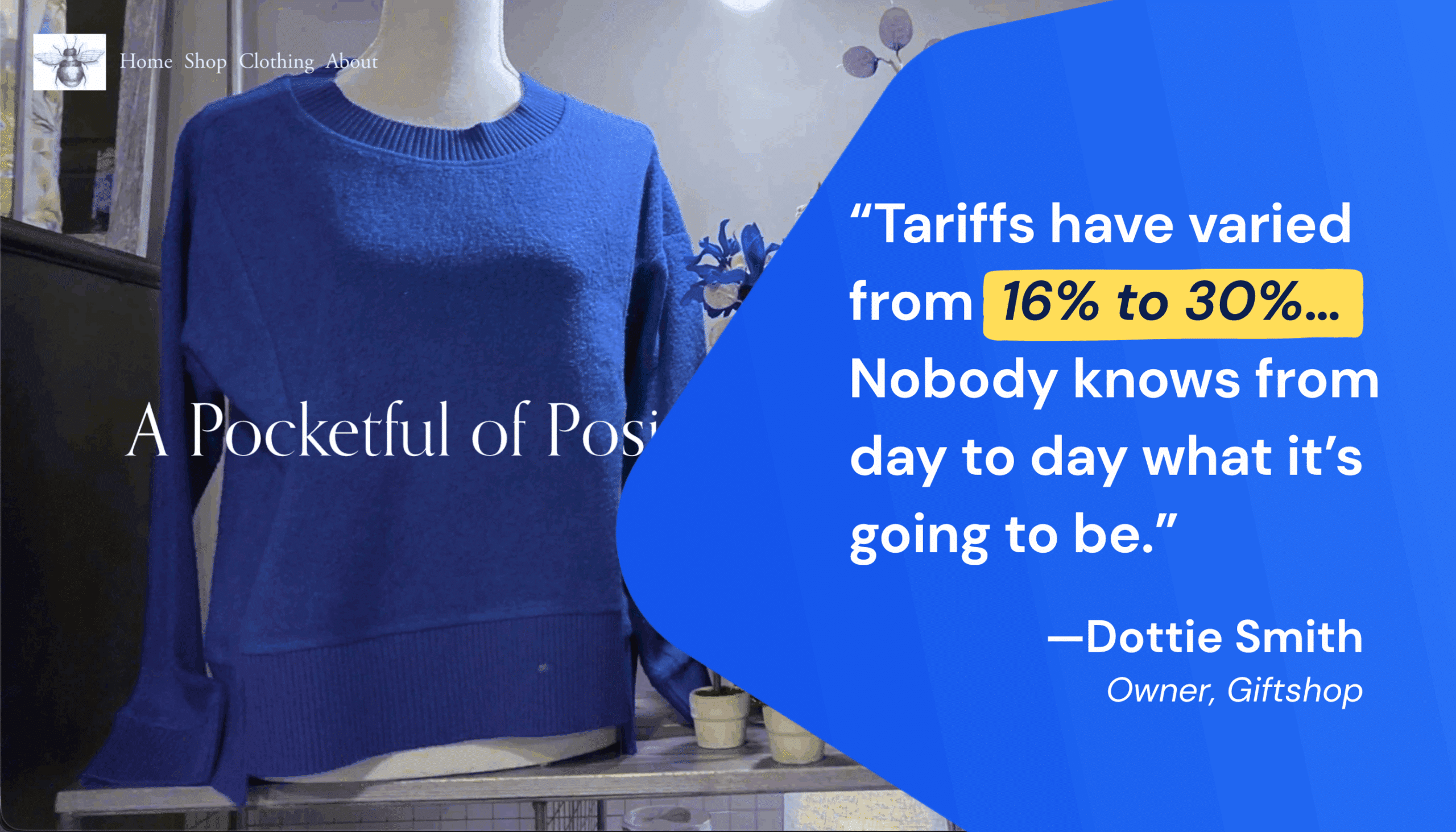
Let’s dive into what’s changing, where traditional automation is failing, and most importantly—how to adapt your Shopify business to thrive despite these new challenges.
How Changing Tariffs Threaten Shopify Automation
Tariff-proofing a Shopify store in 2025 means using automation for real-time landed cost calculation, dynamic pricing, and AI-powered compliance, ensuring you don’t lose profitability to tax and trade rule shifts.
The End of “Easy Imports”
Remember when small packages under $800 sailed through customs duty-free? That era is ending. The elimination of “de minimis” thresholds means even low-value shipments—particularly from China—now face duties they previously avoided.
According to recent research , this shift is already changing consumer behavior, with more shoppers seeking domestic alternatives or higher-value imports that justify the added costs.
Category-Specific Pain Points
Not all products face equal tariff pressure. Electronics, apparel, batteries, and home goods have seen the steepest rate adjustments. A $20 electronic component that once cleared customs easily might now trigger a $5-7 duty, completely erasing your profit margin.
Documentation Demands Intensify
Customs officials aren’t just collecting more duties—they’re scrutinizing paperwork more carefully. Vague product descriptions or missing certificates of origin that once slipped through now cause costly delays.
“Customs requires very specific descriptions now… what each item is, what it is used for, and what it is made of.” shares a business owner in Shopify Community.
The Real Cost Impact
It’s not just direct tariffs—it’s the whole picture:
- Higher freight costs as carriers adjust to new regulations
- Increased compliance expenses for proper documentation
- Longer lead times affecting inventory planning
- Customer service demands for explaining price increases

For Shopify merchants, this translates to thinner margins, more complex operations, and a critical need to rethink automation.
Why Standard Shopify Automation No Longer Works with Tariffs
Your existing workflows weren’t built for this environment. Here’s where they’re breaking down:
1. Cost Calculators Can’t Keep Up
Those landed cost estimators you’ve relied on? They’re likely using outdated duty tables and failing to account for new tariff realities. This leads to incorrect pricing decisions and unexpected margin erosion.
2. Inventory Planning Based on Yesterday’s Logic
Your replenishment automation doesn’t factor in the new reality of customs delays and holds. What was once a reliable 15-day lead time might now stretch to 30+ days, leaving you with stockouts and disappointed customers.
3. Pricing Rules Don’t Adapt Fast Enough
Static pricing rules don’t account for sudden duty increases. That profitable product might silently become a money-loser overnight if your system doesn’t flag the margin change.

4. Fulfillment Workflows Miss Critical Decisions
Most fulfillment automation doesn’t consider whether to offer Delivered Duty Paid (DDP) versus Delivered At Place (DAP) shipping based on destination or product value. This leads to surprise costs for customers—and higher return rates.
5. Accounting Systems Miss the Full Picture
When duties, tariffs, and compliance costs aren’t properly tracked, your financial reports tell a dangerously incomplete story. You might think you’re profitable when you’re actually losing money on every sale. Seasonal discounts that were a no-brainer before might be too much of a margin-slasher now. Here’s what Michael Slate, an Amazon seller, had to say about US Prime day: “With the [tariff] uncertainty, I can’t offer a 20% discount when I don’t know what my product cost is going to be.”
Automation Strategies for Tariff-Proofing Shopify in 2026
The good news? With the right approach, these challenges become manageable. Here’s your playbook:
1. Build Smarter Landed-Cost Tracking
Static cost calculations won’t cut it anymore. You need dynamic, origin-aware pricing that adjusts to the shifting tariff landscape.
Smart approach: Create modular cost inputs that account for duty variations by product category and country of origin. Run “what-if” scenarios for freight, duties, or customs delays to understand your true risk exposure.
Many merchants save significant time by connecting Shopify with QuickBooks using MyWorks Sync . This integration ensures duties, shipping costs, and sales automatically land in your financial records, so margin reports reflect reality—not guesswork. And, with real-time sales & product data in QuickBooks, run forecasting much more accurately than before.
For strategic planning, consider working with a fractional CFO who can help model different cost scenarios and identify the most profitable path forward.
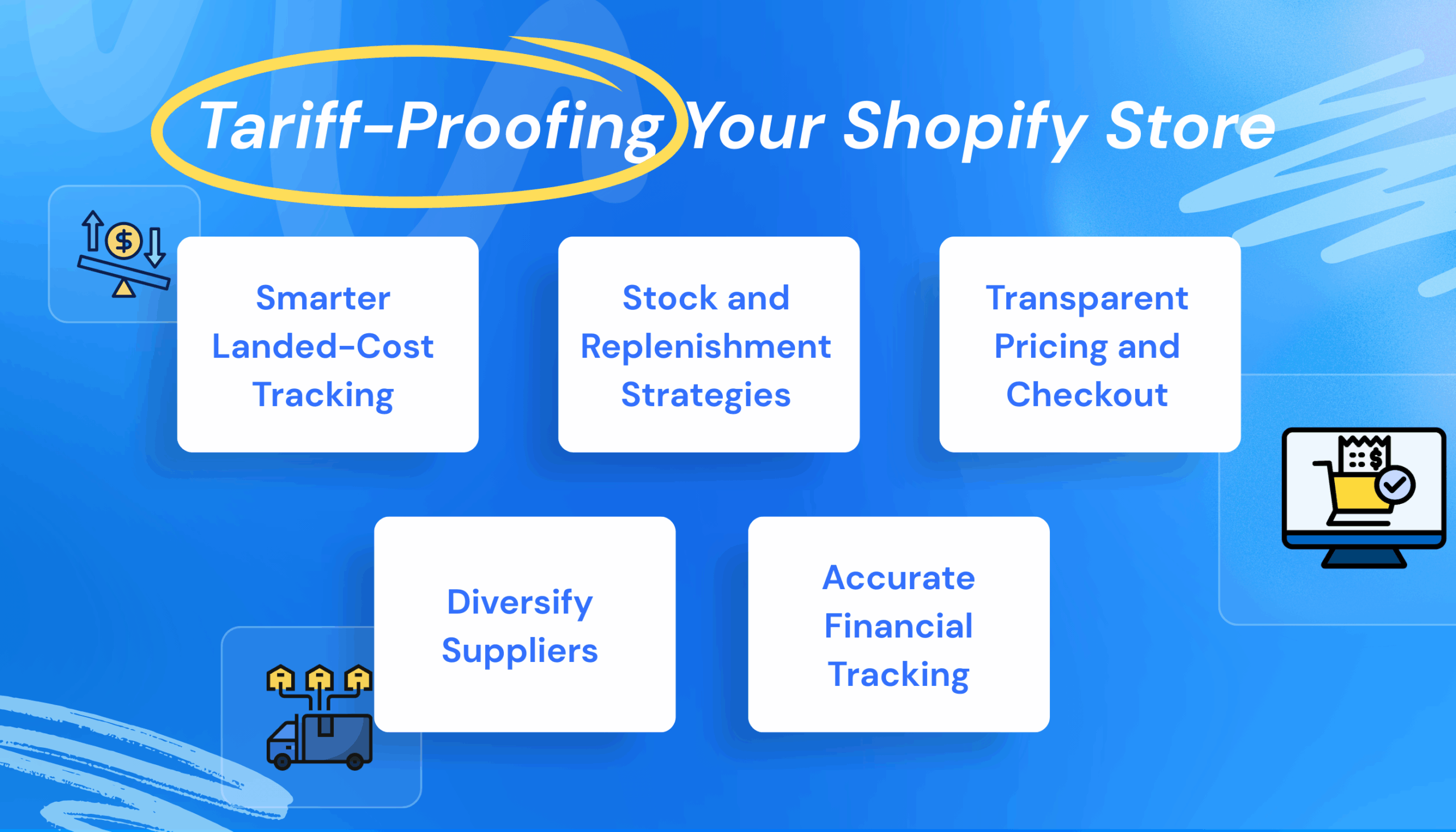
2. Rethink Stock and Replenishment Strategies
When customs delays can stretch from days to weeks, traditional inventory planning falls apart.
Smart approach:
- Add automated lead time buffers for high-risk products from tariff-heavy origins
- Diversify inventory locations to keep stock closer to target markets
- Implement inventory alerts that trigger when tariff shifts make products unprofitable
For more on optimizing operations in this new environment, check out these practical guides on cutting ecommerce operational costs and implementing AI workflow automation for Shopify accounting.
3. Embrace Transparent Pricing and Checkout
Customer surprises lead to abandoned carts and returns. Make duties visible and manageable.
Smart approach:
- Show all duties and taxes upfront at checkout
- Test offering DDP (duties paid) shipping where it improves conversion rates
- Automate customs paperwork to prevent clearance delays
Shopify has recognized this challenge by launching new tariff tools that help merchants collect duties at checkout and reduce return rates tied to surprise fees.
4. Diversify Suppliers Without Creating Chaos
Sourcing flexibility is crucial, but managing multiple suppliers across different regions can quickly become overwhelming.
Smart approach:
- Identify backup suppliers in low-tariff regions
- Create automated sourcing rules that help you switch when costs exceed thresholds
With MyWorks’ accounting automation with multichannel support , you can keep Shopify as your central hub while syncing data cleanly into QuickBooks. This means supplier changes and cross-channel sales don’t turn your accounting into an unmanageable mess.
5. Keep Financial Tracking Airtight
With margins under pressure, accurate financial data becomes more critical than ever.
Smart approach:
- Record duties and brokerage fees in COGS automatically
- Reconcile projected versus actual landed costs weekly
- Create profit models for potential tariff shifts
Implementing these bookkeeping automation tasks can save ecommerce stores up to 10 hours weekly while providing the financial clarity needed to navigate tariff complexities.
Shopify Tariff Automation: Real-World Successes
These strategies aren’t theoretical—they’re already working for forward-thinking Shopify merchants:
Transparent Duties Slash Returns
An apparel brand implemented duty collection at checkout and saw refund requests linked to surprise import fees drop by 40%. Customer reviews improved substantially as expectations were properly set from the beginning.
Strategic Bundling Restores Margins
When a home goods seller discovered their individual low-value items were no longer viable due to new tariffs, they got creative. By bundling complementary SKUs into higher-value sets, they spread duty costs across multiple items while creating more appealing product offerings.
Supply Chain Pivoting Without Downtime
A battery accessory manufacturer relocated production from China to Vietnam in response to tariff increases. Using smart workflow automation , they rebuilt their systems—updating HS codes, certifications, and lead times—without weeks of operational disruption.
Accounting Clarity Through Integration
Tariffs don’t just raise costs, they make accounting messy. When duties, freight fees, and compliance shift daily, outdated tools leave merchants guessing at their true margins. “Your accounting process should be flexible enough to quickly adapt to changing rates,” explains CPA Mary Bredeck.

That’s why so many Shopify merchants turn to MyWorks. It syncs sales, duties, and shipping costs directly into QuickBooks, so reports reflect reality—not guesswork. As Earthfort shared: “MyWorks has been monumental in streamlining our processes and saving my CFO’s time!”
One automotive business owner put it plainly: “Despite our very simple needs, the setup and maintenance of the previous app was complicated and very buggy… MyWorks was simple to set up and use. On top of all of that it is great value for money.”
And for Wade G., support and ease of use sealed the deal: “The customer service is top notch… The app is very user friendly, everything has worked as needed.”
When tariffs are unpredictable, your accounting integration shouldn’t add complexity. It should create clarity and help you adapt faster than competitors.
Your 7-Day Tariff-Proofing Action Plan
Don’t wait for the next tariff announcement to catch you off guard. Here’s what to do right now:

- Audit your product catalog to identify items with high tariff exposure
- Upgrade your landed-cost tracking tools to capture true margins
- Implement duty visibility at checkout to set customer expectations
- Identify backup suppliers in low-tariff regions for key products
- Position safety stock strategically near your major markets
- Set up automated alerts for tariff and trade policy changes
- Communicate transparently with customers about price adjustments
The Future of Tariff-Aware Commerce
By 2026, these adaptations won’t be competitive advantages—they’ll be table stakes. We’re already seeing Shopify and other platforms integrate tariff awareness directly into their core functionality:
- Built-in duty tables and origin tracking
- AI-powered customs classification
- Origin filtering for consumers who prefer local products
- Streamlined compliance documentation
The good news? The tools to succeed in this environment are becoming more accessible to businesses of all sizes. Solutions like MyWorks create a bridge between your Shopify store and accounting system, ensuring that even as tariff policies change, your financial data remains accurate and actionable.
Tariff-Proof Shopify Automation: FAQs
What exactly does “de minimis” mean for Shopify sellers?
De minimis refers to the duty-free threshold for low-value imports. Historically, items under $800 could enter the U.S. without duties, but enforcement is tightening—especially for goods from China. Don’t assume small shipments will avoid duties anymore.
How can I protect my margins when tariffs increase suddenly?
Run automated scenarios to understand impact, link pricing rules to actual landed costs, and consider strategic bundling to spread duty costs across multiple items.
What’s the best way to simplify multichannel accounting with all these tariff complexities?
Keep Shopify as your central hub, then connect it to QuickBooks using MyWorks Sync. This approach avoids messy direct integrations between each sales channel and your accounting software, keeping your reporting clean and accurate.
Should I offer duties-paid (DDP) shipping to my customers?
Yes, when it improves conversion rates and reduces returns. The best approach is to test DDP versus DAP options by region and product category to find the optimal balance between customer experience and cost.
How are successful merchants handling tariff fluctuations in their pricing?
The most adaptable merchants are implementing dynamic pricing models that automatically adjust based on true landed costs, while clearly communicating the value their products deliver regardless of price.
The tariff landscape will continue evolving, but with the right systems in place, your Shopify business can remain agile, profitable, and ready for whatever comes next. The merchants who thrive won’t be those who avoid tariffs entirely—they’ll be the ones who build systems flexible enough to absorb these changes without disrupting their core operations.
